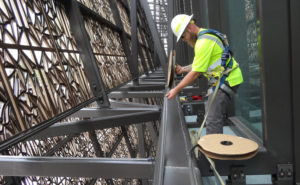
Blue Ridge Wildlife & Pest Management Technician Jason Davis installs Bird-Shock Flex-Track on the roof of the National Museum of African American History & Culture. PHOTO: BLUE RIDGE WILDLIFE & PEST MANAGEMENT
The National Museum of African American History & Culture is a Smithsonian Institution in Washington, D.C. It was established in 2003, but the building itself didn’t open until September 2016. And it is Roanoke, Va.-based Blue Ridge Wildlife & Pest Management’s responsibility to ensure there are no pest birds like pigeons or starlings around to damage buildings or interfere with visitors.
Jason Reger, CWCP, who is president of Blue Ridge as well as a past president of the National Wildlife Control Operators Association (NWCOA), notes that it all started with a federal bid during the construction process back in 2015.
“I gave them an option for an electric track system, then they asked for a design,” Reger recalls. “I hired a guy to create a CAD [computer-aided design] drawing of what I had in mind, and designed the system myself using 14 different systems.”
Reger is no stranger to federal government contract bids. For example, he counts among his clients a Veterans Administration (VA) hospital where he created an integrated wildlife management program — ensuring pond weeds and the wildlife populations were at their cultural carrying capacities.
This Smithsonian project is notable for a few reasons, including:
- Reger worked with Bird Barrier President Cameron Riddell to exactly color-match the Bird-Shock Flex-Track on the “Quaker Bronze” steel of the roof. “When we did our mockup, there’s a balcony near the administration offices. When the administrators went out to look at the roof, they couldn’t see the Shock Track at all,” Reger said. “We needed that uniformity in color so that if no one is specifically looking out the window for it, they don’t even realize it’s there.”
- Every wire was hidden, thanks to Reger’s meticulous measuring of all the spacings needed. He went home and enlisted the help of his two kids — aged 9 and 6 at the time — and they created 2,400 custom jump wires in two weeks. They made a family project out of the task by sitting in the living room, cutting the wires, adding the attachments and doing the heat shrinks. “Most PMPs try to lay shock track as they go, but with a project like this, 75 percent of the work is preparation,” he said. “Preparation is the name of the game.”
The bid goes out every year, and at press time, Reger was working on the next bid to keep the business. The Smithsonian also asked him for a quote to provide maintenance on the bird control systems and the outdoor lights that his firm installed for the electrical contractor on-site during the construction phase of the project. Although Roanoke is about 3.5 hours away from Washington, D.C., the scope of the work and the reputation-building it creates makes traveling worth the cost, he said.
Read more: Build your bird business
Leave A Comment